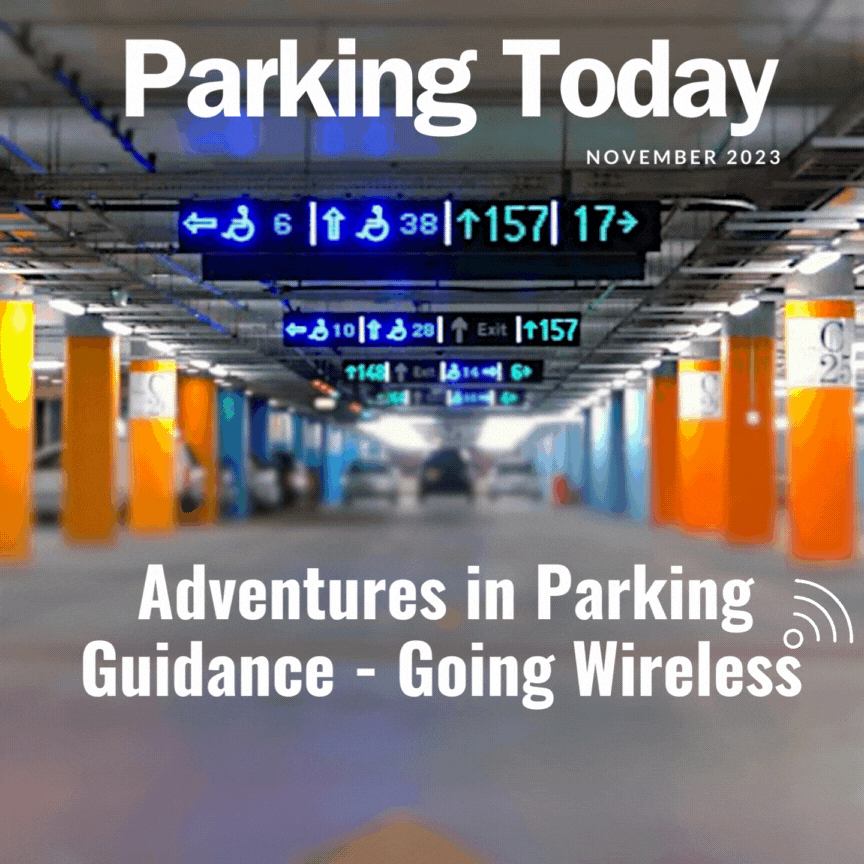
Adventures in Parking Guidance – Going Wireless
We are excited to offer a wireless perspective to wired parking guidance systems that were the focus of Peter Filice’s “Adventures in Parking Guidance – Learnings From Real-Life Installations” in the May 2022 publication in Parking Today. Wireless communications have become a modern standard in many consumer and commercial products we enjoy today – from mobile phones and tablets to Bluetooth headphones and pairing a phone to your vehicle’s audio system. Wireless PGS brings wireless benefits into the parking world and offers answers to many of the challenges raised in Peter’s article.
Coming of Age
It has taken a number of years for the wireless PGS technology to become truly viable, as it has proven a difficult problem to solve – both from the vehicle detection accuracy and the weather and physical load resistance challenges. Interestingly, though originally designed to meet outdoor PGS challenges, with less infrastructure and significantly lower installation costs than traditional wired systems, wireless PGS has proven to be a great fit for many indoor projects, as well.
Wireless PGS – What is it?
In simplified terms, a typical fully “wired” parking guidance system requires electrical and data wires to connect to all critical components of the system – vehicle detection sensors, lights, and Digital Messaging Signs (DMSs). A wireless PGS aims to minimize the system’s reliance on electric and data communication wiring, leveraging battery-operated vehicle detection sensors and long-range radio for data communication between sensors, DMSs and the backend systems, thus significantly reducing a need for extensive conduits and cabling infrastructure.
Cost efficiency
Cost savings vs. wired solutions is one of the biggest factors driving the adoption of wireless PGS solutions. Wired PGS solutions typically involve installation of an extensive power and data cabling network and the overhead sensor support infrastructure – resulting in significant materials, planning, and installation costs. Long installation times also add to missed revenue or opportunity costs. For a wireless PGS, adhesive-based installation of wireless sensors and a limited number of wired elements allow full system installation in a matter of hours and days vs. weeks and even months for a typical wired system. Wireless systems can also be installed in phases, without a need to fully close the facility, minimizing disruptions to the operations.
Effective Traffic Management via Directional DMS
Effective traffic flow management in large built facilities with multiple levels and complex layout typically requires directional DMSs to direct traffic flows. The latest trends with modern DMSs include moving away from a combined fixed segment DMS design (manufactured casings with pre-printed labeling and digital number displays) to full matrix DMSs that can display any kind of text or graphical information and can vary displayed information as project requirements change. DMSs’ wireless data connectivity brings an extra level of flexibility and cost efficiency to a wireless PGS solution.
Simplified Planning and Installations
The wireless nature of key elements of a PGS solution significantly simplifies the planning and installation process. As a great illustration of the high cost of any errors in a wired PGS deployment, in his article, Peter recalls a case of loop wires being embedded in the wrong place vs. painted ramp lanes. Wireless adhesive-installed sensors can easily be re-positioned as necessary to address changes in the traffic patterns and the facility’s layout. Full matrix wireless DMSs allow for an easy change of information displayed and re-positioning of the DMSs, if needed.
With low-profile sensors installed on the ground and no overhead sensor hardware infrastructure, wireless PGS also helps to meet the AFF consideration point in Peter’s article, particularly for the older low-clearance facilities.
Per-space and Counting, Hybrid Solutions
In addition to per-space functionality, wireless sensors can also operate in a counting mode, enabling a cost-effective wireless ingress/egress lane counting solution for many types of facilities – indoor and outdoor. Combining counting and per-space sensors in designated spaces (e.g., EV, Disabled, etc.) can provide just the right mix of data accuracy, granularity, and cost for each specific facility. The wireless nature of such solutions allows them to evolve with time, adding additional per-space monitoring for higher data granularity and accuracy as needed.
One Solution – Indoors, Outdoors, Rooftops
The rooftops, as reflected in Peter’s article, present a particular challenge for traditional wired PGS in a built facility – with a separate level counting or outdoor camera solution typically used in such areas, requiring cross-systems integration at both hardware and software levels. In the case of a wireless PGS, same all-weather wireless sensors are deployed indoors, outdoors and on rooftops – providing a uniform, coherent and highly granular PGS solution for any type of facility.
When it comes to weather resistance, modern wireless parking sensors are built to deliver reliable performance and accuracy even under the most severe weather conditions such as rain, high humidity, low and high temperatures and snow. In addition to surface-mount modification, typically deployed in warm climates and indoors, sensors also can come in an in-ground/flush-mount modification to handle snow-plowing concern in snow-prone climates.
Conclusion
Wireless PGS is not the future. It is here already, taking parking wireless, following in the footsteps of the wireless technological revolution around us. Wireless parking guidance systems can help to address many of the challenges discussed in Peter’s article and to bring PGS solution benefits within reach of parking operations of all sizes.
Paul Ilyasov is CEO of Nwave Technologies. Paul can be reached at pilyasov@nwave.io

